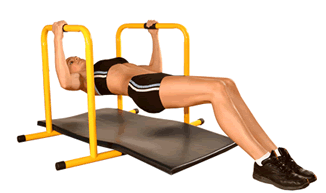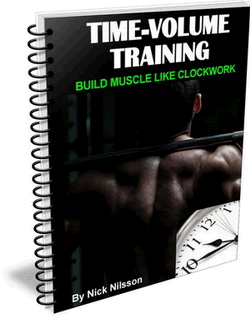Whether you're working out at home or at the gym, the more versatile the equipment you have, the more exercises you can do and the better your results will be.
Can something as elegantly simple as the "The Equalizer" crank up the intensity of your training?

Here's a promotional video from the makers of the Equalizer...
When it comes to training equipment, sometimes the phrase "simpler is better" rings VERY true. And in the case of the "The Equalizer," simple is not only a good thing, it can get you GREAT results!
"The Lebert Equalizer," invented by top Canadian personal trainer Marc Lebert, is very simple in design. On the surface (it comes in two separate pieces), "The Equalizer" resembles two thick yellow hurdles standing a few feet tall and measuring a few feet long, with two "feet" on the bottom for stability and support. It also sports two padded hand grips right in the center of each piece. It looks very simple for sure...
But when you start performing some of the recommended bodyweight exercises on "The Equalizer," you'll see just how powerful "simple" can be.
Now, speaking for myself, I'm a big believer in exercises that use your body for resistance, including variations of push-ups, chin-ups, dips, etc. Exercises that move your body through space have been shown to activate greater numbers of muscle fibers and create much stronger demands on the body, both in the muscular and nervous system, than exercises where you move the weight instead.
Bottom line - bodyweight exercises and exercises that combine weights and body movement (like squats) are more effective than the vast majority of "locked in" exercises where you move the weight and not yourself.
And the sheer number of bodyweight exercises that you can perform with "The Equalizer" makes it one of the most versatile pieces of bodyweight-centric equipment you can get, whether you train at the gym or especially if you train at home.
THE "PROS" of the Lebert Equalizer
1. Easy assembly, simple design, solid construction and no moving parts
"The Equalizer" ships in pieces but is EXTREMELY easy to assemble. It's basically a matter of sliding the pieces together then tightening a few screws. It only took me a few minutes from taking it out of the box to having it ready to go.
The design is simple and the two parts stack together very nicely, making it a great space-saving piece of equipment. And, because "The Equalizer" is basically a base to perform exercises on, there's no need for any moving parts, which means less to go wrong and ZERO maintenance.
The actual frame of "The Equalizer" is constructed of solid steel and, I would say, is pretty much unbreakable in normal use. You would have to really try hard to do any damage to it.
2. Extremely large number of valuable exercises to perform
One of the greatest assets of "The Equalizer" is the fact that it can be used in so many ways. Without looking at the exercise chart that was included in the box, I found myself performing 5 or 6 exercises without even having to refer to it. When I did stop and look at the chart, it gave me some good ideas for further use.
Some of the sample exercises include dips, push-ups, pull-up rows (a.k.a. inverse bodyweight rows), bench dips, knee raises, bodyweight tricep extensions, one-legged squats (used for keeping balance), calf raises, assisted lunges, side push-ups (for obliques), bodyweight inverse curls, and many more! "The Equalizer" website offers a tremendous number of exercise variations that you can put to use immediately.
You can even use it as something to jump over to develop leg power and vertical leap.
And as a dedicated "exercise innovator" myself, I've already come up with quite a few new uses for the equipment.
3. Good stability and portability
For a piece of bodyweight-oriented equipment to be truly useful, it must be stable. This is because you need to balance on it, push your body off it and pull yourself up on it.
The "feet" on "The Equalizer" make the apparatus quite stable for the majority of exercises and I found it to be quite solid. There were a few times when I pushed out to the sides a little too hard and the pieces tilted a bit. But once I understood the limitations, it was simple to work around. Like any equipment, it's important to know what you can and can't do with it. Overall, you can do quite a lot!
The two pieces themselves are extremely light and portable and very easy to maneuver into any position you want to put them in. It's a good combination - solid, stable and portable.
THE "CONS" of the Lebert Equalizer
1. Not as stable laterally (to the sides)
As I mentioned above, when I pushed directly out to the sides, the pieces did tilt a bit. But in that case, I was doing the movement specifically to test lateral stability so it wasn't a big shock when the pieces tilted. To make the units more stable with those types of movements, the feet would have to be much larger, resulting in a larger overall footprint.
Once you know the limits of the lateral pressure you can put on, you can very easily work within them.
2. Not adjustable in height
The only real change I might make to "The Equalizer" would be the ability to change the height of the pieces. As they are right now, the height is set at only one specific point. A couple of removable pins and some height options would give "The Equalizer" even more potential variety in exercises you could do with it.
As it is right now, the height seemed to be just fine for the vast majority of the exercises. With height adjustment, you could potentially make some exercises easier or harder.
*On a side note, I did ask Marc Lebert about height adjustability and they actually do have "add on" legs that can increase the height of the apparatus
Bottom Line
When it comes right down to it, I would HIGHLY recommend "The Equalizer" not only in a regular gym setting but ESPECIALLY in a home gym situation. The sheer variety of exercises and movements you can do with this simple piece of equipment would make it an extremely valuable addition to any training area.
It's even used by a number of professional athletes to boost their sports performance, including Scott Niedermayer of the Anaheim Mighty Ducks (hockey) and Mike Wiebe, Professional Long Driver (golf - best drive 428 yards!).
If you're in a gym setting (e.g. trainer, owner or manager), "The Lebert Equalizer" is also offered in money-saving package deals. That way, you can offer classes using this excellent piece of equipment.
If you just train at a gym, it'll be tough to fit it in your gym bag (unless you bring a suitcase!), but it would be a very good piece of equipment to have at home for days when you don't feel like going to or just can't make it to the gym.
"The Lebert Equalizer" is, overall, an excellent piece of equipment and well worth picking up.
Learn more about The Equalizer here
![]()
More From Fitstep.com
| Stink Training for Bringing Up Weak Bodyparts | |
| How to Spot Reduce Stomach Fat | |
| Exercise At Home With Improvised Equipment | |
| Get a Ripped Six-Pack With Abdominal Sit-Ups |
Share This Page...
---
Home -> Muscle and Strength -> Training Equipment Reviews -> Lebert Equalizer

